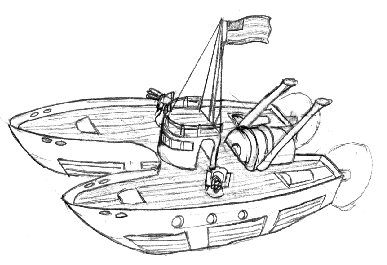Velocity
Velocity Armed Scout
Technical Specifications
The Velocity is the brain-child of Commander James Murphy. Born in 1845, Murphy was the son of a Virginian plantation owner. He enlisted in the Confederate Army when he was 17, just in time to fight in the battle of Fredericksburg. After the war ended, Murphy became dissilusioned with the Army (not forgiving them for surrender). He enrolled at Annapolis and studied naval architecture. Finding a talent there, he first served as an engineer on naval vessels and traveled over South America. He later was assigned to a Navy commission for assisting in the design of new vessels. He worked on the Enterprise class sloops, and later the Atlanta class protected cruisers. Murphy was part of a joint Army / Navy group that drew up the country's plans for an aerial navy. Having requested and been passed over for active duty on the still-notional Eagle class aerial rocket sloops in 1885 (he was 40), Murphy left the Navy to develop his own craft.
Murphy used his naval and aerial architecture know-how to draft many ideas for new aerial vessels. Using his contacts in the Navy and maritime industry, he comissioned the construction of the Velocity. Unfortunately, liftwood is not abundant on Earth. Not to be delayed, Murphy sold his family plantation and shipped 40 tons of partly finished structure and powerplant of the Velocity to Thymiamata. There, he used the last of his money to purchase a hangar on the airfields to live in and complete his craft.
Armor: 1
Hull: 1 (steel)
Speed: 12 (60 knots!)
Engine: 375 HP (ES=3)
Coal: 60 tons
Endurance: 20 days
Altitude: Very High
Tonnage: 118
Cargo: 5 tons
Price: $90,040
Crew: 9 + 1
3 officers
1 deck crew
3 engineers
2 gunners
1 extra cabin
Armament:
(2) 6-pdr HRC armored wing mounts
Special Rules:
As a twin-hulled catamaran, the Velocity is exceptionally stable. As such, it gets +1 against loosing trim. Unfortunately, if trim is lost, there is a -1 penalty to restore it.
Due to the installation of a gyroscope and an "auto-trimsman" device, the helmsman can perform the trimsman's duties without penalties. If both crewmen are available, the Velocity recieves a +1 bonus to maintaining and recovering trim.
Murphy is stubbornly determined to push the United States military into pushing the limits of aerial flyer design. As such, he plans to use the Velocity as a scout, explorer, or whatever is nessisary to get attention.
As the Velocity is a concept vehicle, many novel approaches were taken in her design. First off is the unusual twin hull catamaran design. Although this design is not receptive to large cargo loads or centerline weapon mounts, it has proven exceptionally stable (see special rules). Secondly, a different strain of liftwood (L. arabia, see Challenge article or TRMGS) was used. The improved quality and lifting power of this species allows for more equipment to be built into the flyer. Finally, Murphy was concerned with the ability of a small craft to function with a reduced crew. Thanks to Murphy's special controls, the helmsman can also perform the functions of the trimsman. Because the lift controls can be slaved to a gyroscope, the Velocity can be set into an "auto-trim" mode. Furthermore, only one engineer is needed as long as the craft will not be engaging in combat.
If L. aeria is used, substitute the HRC with two unarmored 0.5" Gatlings, reduce ES to 2, Speed to 9 (45 knots), remove ten tons of coal. The new endurance is 25 days. This version of the Velocity costs $58,560.


Space 1889 is a registered trademark of Frank Chadwick.